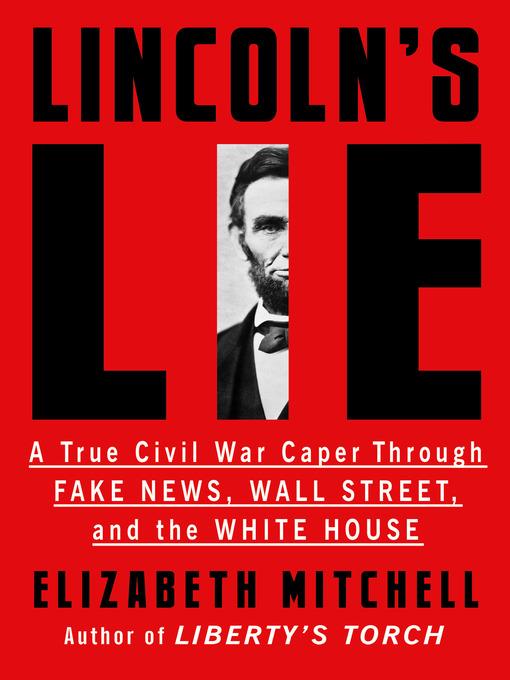
Lincoln's Lie
A True Civil War Caper Through Fake News, Wall Street, and the White House
کتاب های مرتبط
- اطلاعات
- نقد و بررسی
- دیدگاه کاربران
نقد و بررسی

August 3, 2020
Journalist Mitchell (Liberty’s Torch) delivers a dramatic retelling of a Civil War–era mystery. In May 1864, less than a year after President Lincoln’s first compulsory draft sparked riots in New York City, two local newspapers printed a proclamation, signed by Lincoln and Secretary of State William H. Seward, threatening a new draft unless 400,000 volunteers signed up for the Union Army immediately. Lincoln, Seward, and Secretary of War Henry Stanton declared the announcement a hoax and sent troops to halt publication at the newspapers and seize telegraph company communications in search of the culprits. Journalist Joseph Howard soon confessed to the crime as part of a stock- and gold-market manipulation scheme, though he later claimed it was only a practical joke. Rumors circulated, however, that Lincoln had actually drafted a similar proclamation (he made an official call for 500,000 additional troops just two months later), and that it had been leaked to Howard by First Lady Mary Todd Lincoln, who was hoping for a financial windfall to pay off her debts. Mitchell offers plenty of circumstantial evidence in support of the latter theory, and paints a colorful portrait of the rough-and-tumble worlds of 19th-century journalism, politics, and finance. This well-researched account turns a historical footnote into an entertaining whodunit. Agent: Anna Stein.

September 1, 2020
In 1864, states were in rebellion, and civil war raged. No one stood wholly above the fray. Newspaper reporters and publishers vied to get the most compelling, sensational stories into print to feed a public avid for war news. When Lincoln's draft proclamation of another round of conscription was leaked to a reporter, all the papers scrambled to determine if it was indeed genuine; the newly invented telegraph made news travel ever faster. Even Lincoln's normally placid demeanor was said to have turned almost violently angry at this breach of confidentiality. He ordered shutdown of a telegraph company and the arrest of editors of two New York newspapers. No one could determine immediately where the leak occurred, and even the First Lady stood accused. Mitchell (Liberty's Torch, 2018) drives this pulsing narrative relentlessly forward, recreating chaotic scenes in newsrooms as soldiers seized presses and staffs faced arrest and transport to Fort Jefferson, chillingly known as the American Bastille. This thrilling account of a nearly forgotten chapter of Civil War history echoes present-day political controversies.(Reprinted with permission of Booklist, copyright 2020, American Library Association.)

A study of "fake news" and its suppression during the Civil War era. On May 18, 1864, two newspapers in New York City published a presidential proclamation calling for a draft of 400,000 men and a day of fasting and prayer. Unfortunately for the gullible proprietors of the New York World and the Journal of Commerce, the proclamation was a forgery concocted by two journalists who hoped to profit from the expected rise in the price of gold subsequent to publication. In her latest, former George executive editor Mitchell provides the first book-length study of this incident. The author begins with a selection of useful background information--e.g., "While hated in Washington, the World, by the end of 1863, boasted three times the circulation of any other newspaper"--and she capably guides readers through the course of the controversy. Ultimately, President Abraham Lincoln shut down the World and Journal of Commerce for several days and imprisoned the main conspirator, a former New York Times reporter named Joseph Howard, for three months. Mitchell suggests that the hoax was based on a never-released presidential proclamation leaked by Mary Todd Lincoln, an intriguing proposition. However, the author undercuts her arguments with prose that features overlong quotations, odd repetition ("Howard caught his first glimpse of fifty-two-year-old Lincoln, who had just turned fifty-two that day"), and mistakes regarding names (George G. Meade, not "George C. Meade"), dates (the Lemmon Slave Case ruling was in 1860, not 1861), and other facts (the phrase "State of the Union" was not used until 1934) as well as temporal inaccuracies: If a New York City-based ship brings information "once a week to Europe," how can it be a "ten-day journey" to Liverpool? Entertaining at times, but readers seeking a scrupulous account of Lincoln's relations with the press should look elsewhere.
COPYRIGHT(2020) Kirkus Reviews, ALL RIGHTS RESERVED. (Online Review)

























دیدگاه کاربران